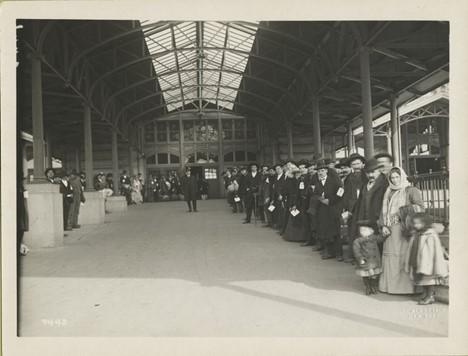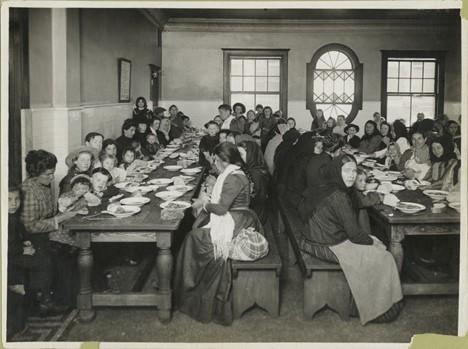The world’s largest online family history resource - Start now
-
Black History Month – Ancestry Initiatives to Honor Black Heritage -
Marking 80 Years Since Auschwitz Liberation: Our Commitment to Holocaust Remembrance -
1921 Census of England & Wales Now Available -
Updated Ancestral Subregions
GET THE LATEST
New posts + monthly newsletter.
GET THE LATEST
New posts + monthly newsletter.
In 1892, Ellis Island—nicknamed the Gate of Freedom—began welcoming immigrants who were seeking refuge from religious persecution, poverty, and political instability. Over the years, more than 12 million people passed through the processing station, giving them a chance to pursue the American dream. Your family members may have been among them, making Ellis Island history records a great place to start learning about the past.
Origins of Ellis Island
Originally, state governments conducted immigration inspections and processed new arrivals. America held such promise for immigrants, however, that state agencies quickly became overwhelmed. They just couldn’t handle the influx of immigrants coming to America to build a better life for themselves. The federal government stepped in to construct an immigration facility at Ellis Island, changing the course of history forever.
Ellis Island as a Gateway for Immigrants

Immigrants passed through the station to determine if they were allowed entry into the United States. Part of the process was a very short medical exam and an interview to decide if they had the means to support themselves. Legal inspectors reviewed answers to questions about immigrants and conducted cross-examinations to identify potentially dangerous immigrants.
However, some immigrants didn’t have such a short experience on Ellis Island. If a doctor determined they had a contagious disease or another medical condition, they were detained in the hospital portion of Ellis Island.
First Immigrants to Ellis Island
After a 12-day trip from Ireland to the United States, 17-year-old Annie Moore became the first person to undergo processing at Ellis Island. She had been separated from her parents for approximately 4 years, so her arrival was more than just a routine stop at the facility—it was a family reunion of sorts. Officials rolled out the red carpet for Moore, giving her two gold pieces and a silver coin. A Catholic priest was also on hand to bless her and wish her well on her journey.
The Role of Ellis Island in American History
Ellis Island was the national immigration station for decades, making it the first stop for many immigrants. Their fate was decided through medical and legal inspections. While the majority of immigrants were allowed into the United States, some were denied entry or separated from their families.
Ellis Island Records
Ellis Island might have closed as an immigration station long ago, but the immigration records remain to tell the story of all the people who passed through its doors. These records offer a glimpse of the past and are a good way to start your family history search.
Information in the Ellis Island records includes ship manifests for immigrants who went through processing at the station. Individual passenger arrival records include details like place of birth, ship name, and arrival date.
Physical characteristics listed include the person’s height, eye color, and hair color. If the immigrant was joining other family members in the United States, their information was also included. Further details include things like their last known residence, occupation, and how much money they brought.
Ellis Island Immigration

When you think of Ellis Island, you might imagine immigrants full of hope or think it was a quick stop before starting life in America. While it was the first stop to a better life for many, it became a long stay or ended in rejection for others. Learning about different Ellis Island experiences helps you better appreciate its history.
Typically, people who had paid for first-class or second-class accommodations on arriving ships didn’t go through the rigorous screening on Ellis Island. Since they could afford better tickets, they weren’t considered a risk to public safety. While they did undergo a quick examination on the ship, they skipped the in-depth inspection on the island. However, people who were sick or had previous legal issues still had to go through the additional processing.
For third-class passengers, the assessment process started with boarding a ferry to take them to Ellis Island. That’s where they would undergo the health and legal inspections to determine if they were approved to stay.
Challenges Faced by Minorities and Marginalized Groups
Members of marginalized groups, such as people with disabilities and immigrants who lacked financial stability, endured more rigorous inspections on Ellis Island. For instance, unescorted women had more difficulty because they were likely to become public charges. Women needed to be with a man who was related to them to leave the island. People with a criminal past were often denied entry as well.
In 1882, President Chester Arthur signed the Chinese Exclusion Act, which banned Chinese laborers from immigrating to the United States for a period of 10 years. Officials at Ellis Island were responsible for enforcing this ban. Later, Japan promised to restrict the immigration of its laborers to the United States. This promise, known as the Gentleman’s Agreement, had a lasting impact on the composition of the U.S. population.
Impact of Ellis Island
Although Ellis Island closed in 1954, what happened there continues to affect almost every aspect of American life. For example, Isaac Asimov, Irving Berlin, Frank Capra, and Bob Hope are just a few of the famous people who passed through the Gate of Freedom before they shared their talents with other Americans. If you visit Ellis Island, you can almost hear the voices of the millions of people who came to the United States seeking more opportunities for themselves and their loved ones.
Start your family history search with Ellis Island immigration records to learn more about how your family probably arrived in the United States. A free trial of Ancestry® can help you trace your family history.
Sources
-
- https://www.statueofliberty.org/ellis-island/overview-history/
- https://www.pbs.org/wgbh/americanexperience/features/goldman-immigration-and-deportation-ellis-island/
- https://cmsny.org/from-the-cms-archive-separation-of-families/
- https://journals.uair.arizona.edu/index.php/azjis/article/download/18590/18232
- https://www.archives.gov/milestone-documents/chinese-exclusion-act
- https://history.state.gov/milestones/1899-1913/japanese-relations
- https://www.nps.gov/elis/notable-immigrants-of-ellis-island.htm
- https://www.statueofliberty.org/ellis-island/overview-history/
- https://www.pbs.org/wgbh/americanexperience/features/goldman-immigration-and-deportation-ellis-island/
- Image 1: https://www.loc.gov/item/2014710703/
- Image 2:
- https://commons.wikimedia.org/wiki/File:Passed_and_waiting_to_be_taken_off_Ellis_Island._(3109323235).jpg
- Image 3: https://docs.google.com/spreadsheets/d/1s_mRTv_LCSRRsVZrZH7AzPNukeuOXUK2nJQEwy79bJ0/edit#gid=0
Original source: https://www.flickr.com/photos/nypl/3109320685
























